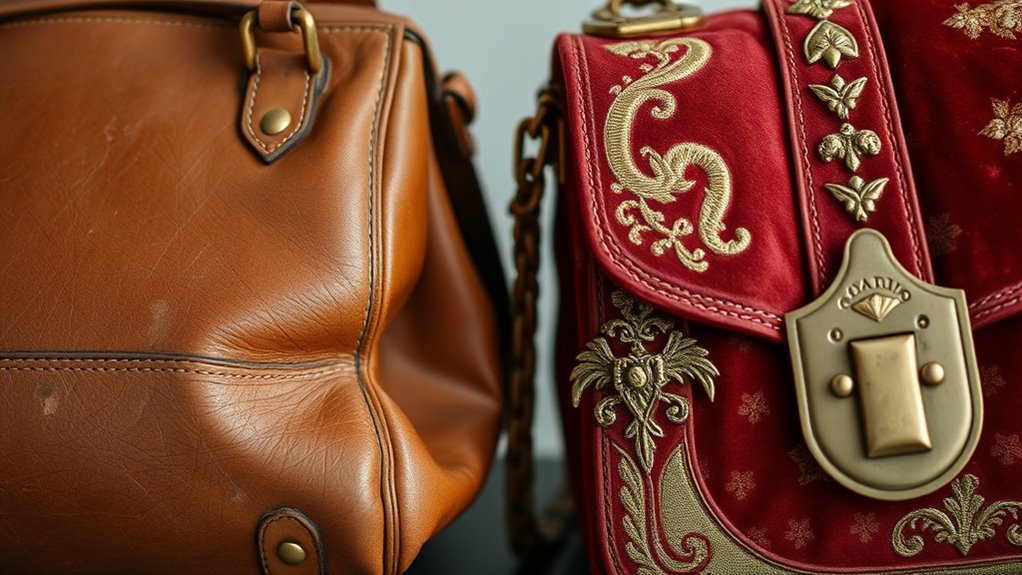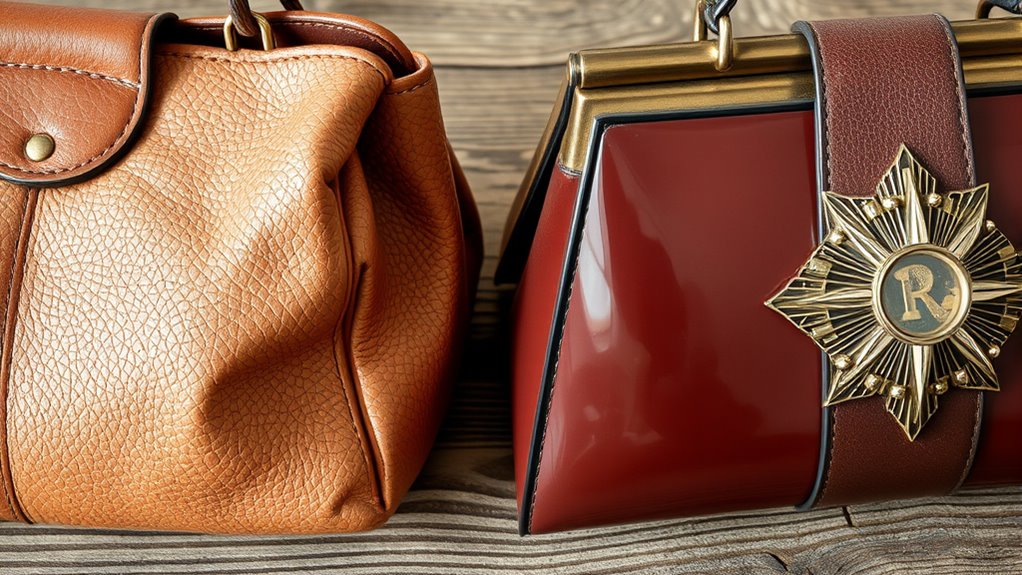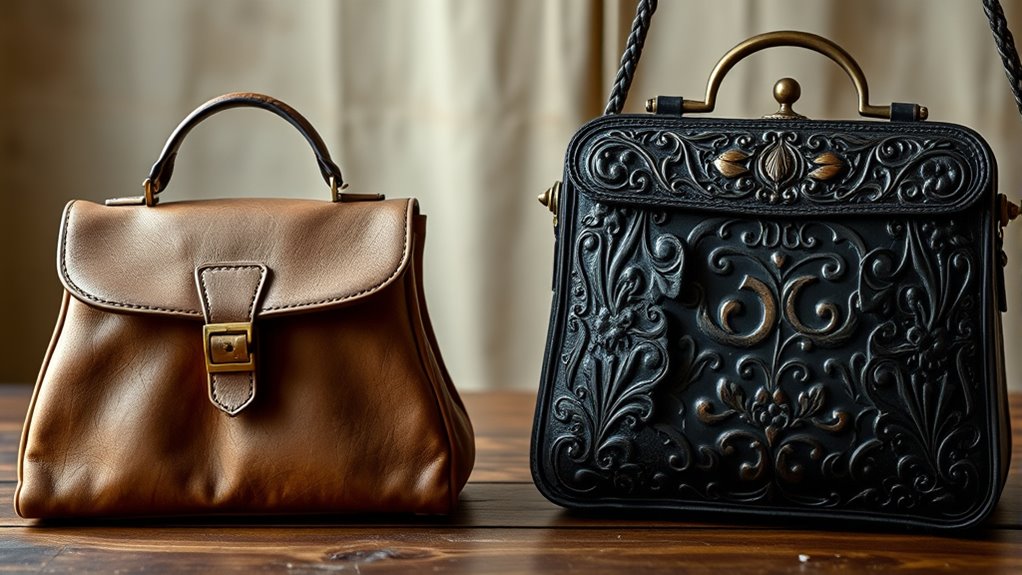To correctly date your handbags, first distinguish between vintage (20-100 years old) and antique (over 100 years old) by examining design details, materials, and branding cues. Vintage bags often reflect specific era styles with period logos, while antiques showcase handcrafted craftsmanship and aged leather. Pay attention to hardware, stitching, and construction techniques, as these help identify the age. Continue exploring to uncover expert tips that will help you authenticate and date your collection more accurately.
Key Takeaways
- Check the handbag’s age: 20-100 years old typically indicates vintage; over 100 years suggests antique status.
- Examine materials and craftsmanship: hand-stitching and natural leathers point to older bags; machine-made and synthetic fabrics indicate newer or mid-century pieces.
- Look for era-specific hardware and logos: period-appropriate hardware helps date the bag accurately.
- Identify signs of aging: patina, tarnished hardware, and aged leather support authenticity and age estimation.
- Review provenance and markings: manufacturer details and production dates confirm whether the handbag is vintage or antique.
Defining the Terms: What Makes a Bag Vintage or Antique?

Understanding what distinguishes vintage from antique handbags can be confusing, but knowing the key differences helps you make informed choices. Vintage bags typically date from 20 to 100 years ago, often reflecting the popular color palettes of their era, which can influence their appeal. Antique handbags are generally over 100 years old, embodying craftsmanship and design elements from a different time. Branding strategies also differ: vintage bags often feature logos or labels that reveal the brand’s identity during that period, while antiques may lack modern branding altogether. Recognizing these distinctions helps you identify a bag’s age and historical significance. Whether it’s the color palettes or branding cues, knowing these factors makes it easier to determine if a handbag is vintage or antique. Color palettes and branding cues are important factors to consider when evaluating a handbag’s age.
Manufacturing Techniques and Materials Across Eras

Manufacturing techniques and materials used in handbag creation have evolved considerably over the decades, reflecting technological advances and changing fashion trends. When examining vintage or antique bags, you’ll notice differences in craftsmanship and material quality. For example, early bags often featured hand-stitched seams and natural materials like leather, showcasing artisanal skills. Mid-century handbags incorporated machine sewing, synthetic fabrics, and more structured shapes, aligning with luxury branding trends. Modern pieces emphasize precision manufacturing, durable synthetic materials, and innovative hardware, appealing to today’s resale market. Understanding these techniques helps you identify a bag’s age and authenticity. The craftsmanship and materials also influence a bag’s value, especially in the resale market, where vintage pieces with superior manufacturing often command higher prices. Manufacturing techniques and materials are key indicators of a bag’s era and originality.
Key Features and Design Elements to Identify Age

By examining the design features and details of a handbag, you can often determine its age and authenticity. Look for rare finds like specific hardware styles, stitching techniques, and craftsmanship details that reflect certain eras. For example, vintage bags from the 1950s often feature structured shapes and metal clasps, while antique pieces may have hand-stitched seams and leather that shows signs of age. Pay attention to branding, logos, and hardware finishes, as these can reveal the period of production. Collector’s tips include noting subtle design elements unique to specific decades, such as the type of handles or decorative accents. Recognizing these key features helps you accurately date your handbag and spot genuine vintage or antique treasures. Additionally, understanding Dog breeds can provide insights into the durability and materials used in some handcrafted handbags, which may have been influenced by traditional techniques from different regions.
Historical Context and Its Role in Dating Handbags

Understanding the historical context helps you pinpoint a handbag’s age more accurately. By examining style trends, manufacturing techniques, and significant events, you can better identify when a piece was made. This approach adds depth to your dating process and reveals the handbag’s true story. Recognizing antique characteristics such as construction details and material quality further enhances your ability to authenticate and date vintage handbags accurately.
Style Trends Over Time
Since fashion trends evolve rapidly, recognizing the distinctive style elements of different eras can help you accurately date handbags. Celebrity influence and fashion industry trends often shape handbag designs, making style a key clue. To identify the era, look for:
- Shape and Silhouette – Clutch styles from the 1920s differ from the boxy bags of the 1960s.
- Materials and Hardware – Art Deco motifs highlight the 1920s, while bold metal accents reflect the 1980s.
- Details and Embellishments – Beading and embroidery often signal vintage styles, especially during the 1930s and 1940s when glamour was prominent.
Manufacturing Techniques Evolution
The evolution of manufacturing techniques plays a crucial role in dating handbags, as advances in production methods reflect broader technological and cultural shifts over time. By examining leather aging, you can see how different tanning and finishing processes impacted the handbag’s appearance. Older bags often show natural leather aging, with patinas developing gradually, indicating traditional craftsmanship. Dyeing techniques also reveal their era; earlier methods used natural dyes resulting in softer, more muted colors, while modern dyeing produces brighter, more uniform hues. Understanding these manufacturing differences helps you identify whether a handbag is genuinely vintage or antique, based on subtle clues like leather texture and color consistency. Recognizing these techniques allows you to better assess a handbag’s age and authenticity, making your evaluation more accurate. Additionally, knowledge of Gold IRA Rollovers can inform how collectors diversify their investments in vintage items, ensuring long-term financial security.
Historical Events Impact
Historical events profoundly influence handbag designs and production, serving as markers of their time. Major moments in history often shape the fashion industry and reflect societal shifts. For example, during wartime, materials like leather and metal became scarce, leading to simpler, more functional bags. Celebrity influence also plays a role; when a star endorses a particular style, it quickly gains popularity. To identify the era of a handbag, consider:
- The impact of global events on materials and craftsmanship.
- How celebrity trends influenced design choices.
- Changes in the fashion industry, such as the rise of luxury brands or mass production.
- The use of specific materials that can indicate a particular period or manufacturing method.
Practical Tips for Authenticating and Dating Old Bags

To authenticate and date old handbags, start by carefully examining the materials and craftsmanship for signs of age and originality. Look closely at the hardware and logos, as these often reveal manufacturing periods and brand authenticity. Additionally, understanding the style and trends of different eras helps you identify whether a bag truly matches its claimed age. Recognizing automation technologies in manufacturing can also provide clues about the period when a handbag was produced.
Analyzing Material & Craftsmanship
Examining the materials and craftsmanship of a vintage or antique handbag can reveal key clues about its authenticity and age. First, assess the leather quality; older bags often use thicker, more supple leather with natural imperfections, unlike modern synthetic alternatives. Second, observe stitching techniques—hand-stitched seams tend to be uneven and tighter, indicating older craftsmanship, while machine stitching is more uniform and precise. Third, check the overall construction: vintage and antique bags typically feature reinforced seams and meticulous finishing, reflecting skilled craftsmanship. By paying close attention to these details, you can better determine the bag’s period and authenticity. Remember, genuine older handbags often showcase unique qualities in leather and stitching that newer reproductions lack.
Examining Hardware & Logos
How can you verify a vintage or antique handbag’s age and authenticity? Start by closely examining hardware details. Authentic vintage and antique bags often feature hardware made from high-quality metals like brass or gold-plated finishes, with signs of aging such as patina or slight tarnishing. Look for stamped or engraved logos on hardware components—these can reveal the brand’s identity and timeframe. Pay attention to logo designs; older logos tend to be simpler or more engraved, while modern reproductions may have more intricate or altered logos. Compare hardware styles and logo placements with reputable sources or brand archives. Authentic hardware and consistent logo designs are key clues to dating and authenticating a handbag, helping you distinguish genuine vintage or antique pieces from reproductions. Additionally, petantina and tarnishing can indicate an item’s age, as these signs develop over time and can be difficult to replicate in modern counterfeit pieces.
Understanding Style & Trends
Understanding a handbag’s style and trends is essential when authenticating and dating vintage or antique pieces. Fashion evolves, but certain elements help identify age and origin. Consider these key points:
- Recognize design features influenced by modern accessories, such as minimalist shapes or bold colors, which signal contemporary trends.
- Look for details inspired by celebrity influences, like logo placements or signature patterns popularized by stars.
- Study the silhouette and hardware, noting that antique bags often feature ornate details, while vintage styles reflect their era’s fashion trends.
- Incorporate Bedroom elements like vintage decor and rustic accents to better understand the context and period of the handbag’s style.
The Importance of Provenance and Markings in Dating

Provenance and markings play a crucial role in accurately dating vintage and antique handbags, as they provide authentic clues about a bag’s origin and era. Recognizing provenance significance helps you verify authenticity, while marking identification reveals details like manufacturer and production date. These details help prevent counterfeit purchases and guarantee proper valuation. Understanding craftsmanship quality can further assist in assessing the handbag’s age and authenticity.
Frequently Asked Questions
How Can I Determine a Handbag’s Approximate Manufacturing Year?
To determine a handbag’s approximate manufacturing year, start by examining the material analysis; different eras favored specific materials like leather, canvas, or synthetic fabrics. Next, look at the hardware design—styles, logos, and clasps evolve over time. Research brand-specific details and serial numbers if available. Combining these clues helps you estimate the handbag’s age accurately, giving you a clearer understanding of its vintage or antique value.
Are There Specific Brands More Likely to Produce Vintage or Antique Bags?
Certain brands are more likely to produce vintage or antique bags due to their popularity and history. Luxury branding like Louis Vuitton, Chanel, and Hermès often have iconic designs from earlier periods, making their older pieces highly collectible. These brands also use traditional production techniques, which help date their bags. Knowing a brand’s history and craftsmanship style can help you identify whether a bag is vintage or antique.
What Common Fake Features Should I Watch Out for in Old Handbags?
When checking old handbags, watch out for counterfeit indicators like inconsistent stitching, incorrect hardware, or poorly printed logos. Fake hallmark signs often include misspelled brand names or suspiciously cheap materials. You should also scrutinize zippers and linings for authenticity. If something looks off or doesn’t match genuine features, it’s likely a fake. Being vigilant helps you spot counterfeits and make sure your handbag’s true vintage or antique value.
How Does the Condition Affect the Age Estimation of a Handbag?
Think of your handbag as a storybook; its condition reveals the chapters written over time. Wear and restoration can blur the lines of age, making it tricky for a collector’s assessment. Dents, fading, or repairs might hide its true vintage or antique roots. By examining these signs carefully, you can better gauge its age, understanding how restoration impacts value and authenticity, helping you determine if it’s a true treasure or a clever imitation.
Can a Handbag’S Style Help Identify Its Era Beyond Materials?
You can often identify a handbag’s era by examining its style, as design evolution reflects fashion trends of specific periods. Look for details like hardware, shape, and decorative elements that align with certain decades. Understanding how fashion trends influenced handbag designs helps you date pieces more accurately, beyond just materials. Recognizing these stylistic clues allows you to distinguish between various eras and appreciate the handbag’s historical context.
Conclusion
Just as time reveals the true story behind a masterpiece, understanding a handbag’s vintage or antique status uncovers its unique history. By recognizing era-specific details, craftsmanship, and markings, you become a detective of style, much like Indiana Jones uncovering hidden treasures. Trust your eye and research—the past whispers through every stitch and stamp. With patience, you’ll find that every bag is a chapter in the grand story of fashion’s enduring legacy.









